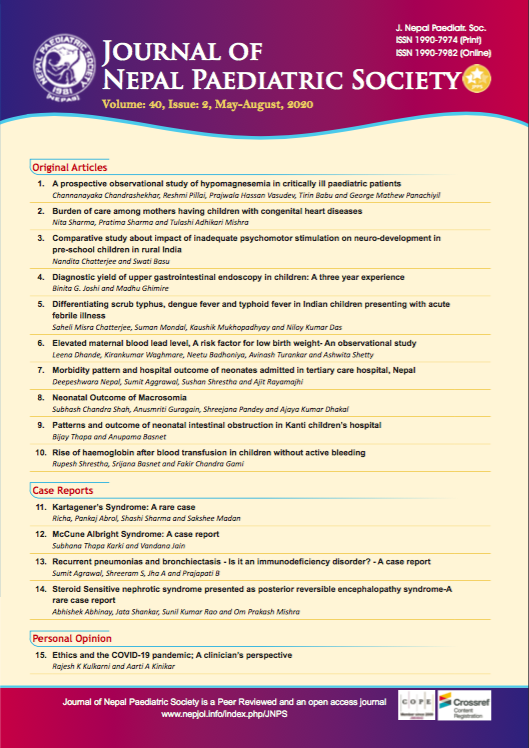Diagnostic Yield of Upper Gastrointestinal Endoscopy in Children: A Three Years Experience
DOI:
https://doi.org/10.3126/jnps.v40i2.29321Keywords:
Chronic abdominal pain, Gastroduodentitis Paediatrics, Upper Gastrointestinal EndoscopyAbstract
Introduction: Gastrointestinal disorders are very common in paediatric population. Upper Gastrointestinal Endoscopy procedures have increased dramatically worldwide and have contributed in identification of various gastrointestinal disorders along with therapeutic benefits. However, it is recently being established in paediatric population in Nepal and proper data is scarce. This study was aimed to assess upper gastrointestinal endoscopy with respect to its indications and diagnostic yield at a tertiary centre over a three years period.
Methods: This is a retrospective observational study where data of all paediatric patients between the age group 0 - 15 years having various gastrointestinal problems who underwent upper gastrointestinal endoscopy from March 2013 - Feb 2016 in our centre were analysed.
Results: Among 270 patients, males comprised 60% and females comprised 40%. Age range was 0 - 15 years and majority were from the age group between 10 to 15 years (66.2%). Most common indications for endoscopy were chronic abdominal pain (58.8%), acute epigastric pain (18.5%), followed by failure to thrive (7%). Abnormal findings were detected in 250 patients (92.5%); gastroduodenitis (28.14%), antral gastritis (18.51%), erosive gastritis (15.92%), duodenitis (9.25%), hiatus hernia (7.4%), varices (5.5%) were common findings. Histopathologically, chronic gastritis and duodenitis (72%) were common findings followed by acute gastritis and giardiasis. Among 80 patients who underwent RUT, 50% each had positive and negative results.
Conclusion: Chronic abdominal pain remains common gastrointestinal problem in children. With the advent of upper gastrointestinal endoscopy various gastrointestinal problems can be identified and managed accordingly. Along with the facility of histopathology, diagnostic yield and outcome is further enhanced.
Downloads
Downloads
Published
How to Cite
Issue
Section
License
Authors who publish with this journal agree to the following terms:
Authors retain copyright and grant the journal right of first publication with the work simultaneously licensed under a Creative Commons Attribution License that allows others to share the work with an acknowledgement of the work's authorship and initial publication in this journal.
Authors are able to enter into separate, additional contractual arrangements for the non-exclusive distribution of the journal's published version of the work (e.g., post it to an institutional repository or publish it in a book), with an acknowledgement of its initial publication in this journal.
Authors are permitted and encouraged to post their work online (e.g., in institutional repositories or on their website) prior to and during the submission process, as it can lead to productive exchanges, as well as earlier and greater citation of published work (See The Effect of Open Access).



